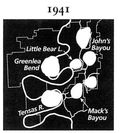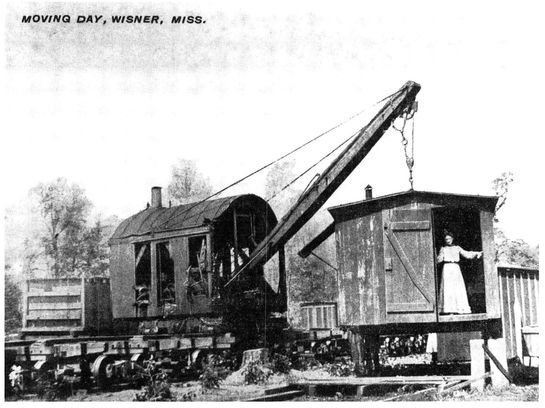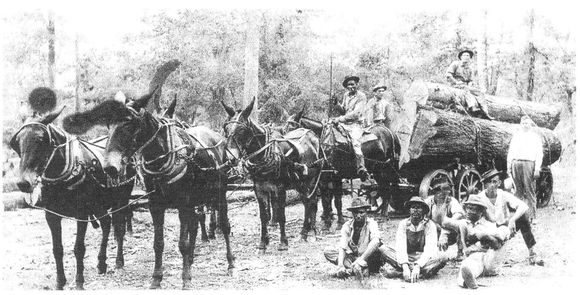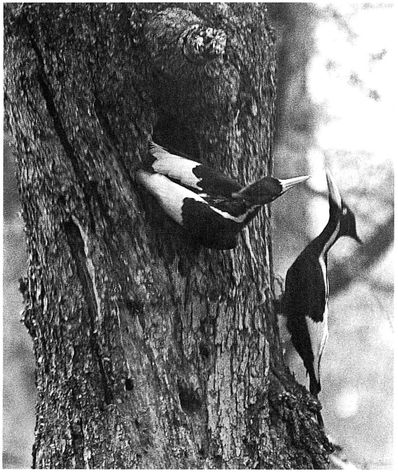The Race to Save the Lord God Bird (13 page)
Read The Race to Save the Lord God Bird Online
Authors: Phillip Hoose

THE RACE TO SAVE THE LORD GOD BIRD
All the men in the village worked in the mill or for it. It had been there seven years and in
seven years more it would destroy all the timber within its reach. Then some of the
machinery and most of the men who ran it and existed because of and for it would be
loaded onto freight cars and moved away.
seven years more it would destroy all the timber within its reach. Then some of the
machinery and most of the men who ran it and existed because of and for it would be
loaded onto freight cars and moved away.
âWilliam Faulkner,
Light in August
(1932)
Light in August
(1932)
T
HE CHICAGO MILL AND LUMBER COMPANY MADE WOODEN BOXESâCASKETS, SHELL boxes, wagon seats; anything with four sides, a top, and a bottom that a customer might order. After the Great Chicago Fire of 1871, it soon needed more wood than the pine forests around the Great Lakes could supply. In 1898 it bought a sawmill in Greenville, Mississippi, that came with a warehouse full of logging equipment and twenty-five thousand acres of big delta trees. Hiring dozens of local men, it set about planing the best wood into boards for furniture makers and slicing up the second-class wood into box parts. Soon Chicago Mill's tugboats were proudly pushing its lumber to market down the Mississippi River on the company's private fleet of barges, often escorted by its private steamboat, the
Hazel Rice.
HE CHICAGO MILL AND LUMBER COMPANY MADE WOODEN BOXESâCASKETS, SHELL boxes, wagon seats; anything with four sides, a top, and a bottom that a customer might order. After the Great Chicago Fire of 1871, it soon needed more wood than the pine forests around the Great Lakes could supply. In 1898 it bought a sawmill in Greenville, Mississippi, that came with a warehouse full of logging equipment and twenty-five thousand acres of big delta trees. Hiring dozens of local men, it set about planing the best wood into boards for furniture makers and slicing up the second-class wood into box parts. Soon Chicago Mill's tugboats were proudly pushing its lumber to market down the Mississippi River on the company's private fleet of barges, often escorted by its private steamboat, the
Hazel Rice.
The Singer Tract, with the Tensas River snaking through it. Important Ivory-bill habitats are in white

In 1928 Chicago Mill bought another sawmill in the shadow of a huge wilderness forest owned by none other than the Singer Manufacturing Company. There were mammoth trees in those woods, oaks and sweet gums that would send furniture makers down on their knees in praise. Chicago Mill built a box factory in Tallulah, Louisiana, and went to see the Singer people.
The timing was perfect. High in his New York City skyscraper office, Singer
president Douglas Alexander had taken to fuming at “flappers,” blaming them for a sudden drop-off in U.S. sewing machine sales. He didn't care if they bobbed their hair and smoked and danced and droveâbut couldn't they just keep
sewing?
To Alexander, emancipated women were taking away a whole generation of sewersâmeaning Singer customers.
president Douglas Alexander had taken to fuming at “flappers,” blaming them for a sudden drop-off in U.S. sewing machine sales. He didn't care if they bobbed their hair and smoked and danced and droveâbut couldn't they just keep
sewing?
To Alexander, emancipated women were taking away a whole generation of sewersâmeaning Singer customers.
It made little sense for the company to keep paying taxes year after year on 120 square miles of trees in Louisiana that it no longer seemed to need. So in 1937 Singer sold off a small piece of its landâsix thousand acresâto the Tendall Lumber Company. Two years later, it sold Chicago Mill the right to cut all the restâabout seventy-three thousand acres of mostly virgin forest.
THE SANTEE COOPER PROJECT
About the same time Chicago Mill began cutting the Singer Tract, the Ivory-bill suffered another blow in South Carolina. On April 18, 1939, loggers began cutting huge cypress and live oak trees in the floodplain of the Santee River to make way for a dam. The idea was to back the river's water up into two lakes behind the dam so that South Carolinians could swim, boat, and fish. Building the dam would also create jobs at a time when many people were out of work. Some of the river's water would flow through a “spillway,” or door, at the dam, turning turbines to create electric power.
Families who lived in the forested area along the river were moved out and told to become farmers. They were given one hundred free chickens and loans to buy seed. Homes, churches, schools, and even cemeteries were moved out of the way. On November 12, 1941, spillway doors were closed against the river and lakes Marion and Moultrie began to fill up behind the dam.
Though Jim Tanner didn't find Ivory-bills when he explored the Santee River swamp in 1937, he was convinced they were still there. The Santee Cooper Project, as the dam was called, removed the last sizable habitat for the Ivory-billed Woodpecker in South Carolina.
In 1939, after building railroad tracks from Tallulah out to the forest, Chicago Mill started logging the west side of the Tensas River. The railroad made everything portable-even families. Tiny prefabricated one-room shacks were pitched onto flatcars and hauled by train into the woods, where they were unloaded and set down in rows on a patch of cleared land near the cutting site. White workers lived on one end of a row, and blacksâwho outnumbered whites and did the hardest workâon the other. When the job was finished in one part of the forest, families helped pick up their own homes and heave them back onto the train to be hauled off to the next work site.
The hoots of Barred Owls, the electric chatter of tree frogs, the hair-raising cries of wolves, and the tooting calls of Ivory-billed Woodpeckers were soon drowned out by the grinding, growling machines. “Those woods were
loud,”
recalls Gene Laird, who grew up in the forest during those years. “The train whistle was earsplittingâfour blasts meant âget off the track.' Axes rang, people yelled and whoop-whooped to be heard, and behind it all the crawler tractors hauling logs were always growling.”
loud,”
recalls Gene Laird, who grew up in the forest during those years. “The train whistle was earsplittingâfour blasts meant âget off the track.' Axes rang, people yelled and whoop-whooped to be heard, and behind it all the crawler tractors hauling logs were always growling.”
The loggers worked seven days a week from dawn till duskâor from “can” till “can't,” as they put it. They worked in the rain and they worked in the cold. When the ground was too soggy for sawyers to stand on, they drove a long wedge called a kickboard into the trunk of a tree. A man hopped up onto each end. From their dry perch, the duo counted out “One, two, three!” and began to push and pull a twelve-foot-long crosscut blade to the rhythm. First it bit into the thick gray trunk. Then it entered the sapwood, slicing back and forth through wood that was laid down during the early part of the twentieth century. Then it reached the heartwood, penetrating wood dating from the Civil War and earlier, until the tree began to sway, gently at first and then teetering violently, until there was a last long dying crack. Then the tree came screaming down, tearing through the limbs of trees beside it, striking the earth with a boom that shook the forest for a few final seconds. Bouncing once or twice, it at last lay still and then was set upon by ax-wielding men who chopped the trunk into neat logs. The logs were dragged away two at a time by tractor-driven “skidders” to boxcars that were always waiting at the rail, doors wide open like the mouths of babies waiting to be fed.
A portable shack in an early-twentieth-century Mississippi logging camp is lifted up on a railroad car with a woman still in residence

Loggers at the Singer Tract in 1939, before most African American workers left to fight in World War II or work in factories in the North

THE SWAMP DATE
And so the race was on: could the last Ivory-bill forest be saved before the Lord God bird ran out of food? With the wilderness shrinking every day, Audubon's John Baker flew into action. Early in 1940 he got Louisiana politicians to introduce a bill into Congress to create a “Tensas Swamp National Park.” If passed into law, this bill, numbered H.R. 9720, would stop the cutting and protect up to sixty thousand acresâwhat was left of the Singer Tract. The U.S. government would take over the land and run it as a park, complete with visitor programs. One catch was that the bill didn't propose allocating any money for the government to buy the landâit would have to be raised. Baker knew the bill would be hard to pass, since few northern politicians would care much about a forest in the Deep South. Majestic mountainous places like Yosemite or Rocky Mountain National Park were one thing, but who would care about making a park out of a swamp in Louisiana?
Baker wrote to President Franklin D. Roosevelt asking him to support the bill. He also asked the governor of Louisiana to find money to buy the land and wrote to Chicago Mill's president requesting a meeting to talk about selling the company's logging rights. The company was slow to answer. When a reply finally came, Chicago Mill's president said he doubted that anything could be worked out that would satisfy both the company and the woodpecker. “That remains to be seen,” Baker scrawled defiantly on the envelope.
In Louisiana, gum and oak trees kept thundering to the ground throughout the summer and fall of 1940. Baker suspected Chicago Mill was working at breakneck speed, trying to get the trees cut before a park could be established. Four hundred miles away, at a small college deep in the Appalachian Mountains, Dr. James Tanner, now a biology professor at East Tennessee State, was also worried about what was going on at the Singer Tract. Besides wanting to see for himself, he had fallen in love, and he wanted to show slender, red-haired professor Nancy Sheedy the most important place in his life before it was too late.
The young couple drove to Tallulah over the Christmas break and were soon wearing hip boots and hiking into John's Bayou, where they heard Ivory-bills yapping but couldn't find them. From time to time the low rumble of tractors was faintly audible in the background, but the crew sounded far away. When sunlight began to fade, they hiked out. Jim thought he knew the tree where the Ivory-bills would roost that night. They could find it in the morning.
At 4:30 a.m., Nancy was waiting on the sidewalk in front of the hotel when Jim pulled up, breakfast and lunch packed in fresh paper sacks on the seat. When they reached the forest, the sky was still starry and the woods were pulsing with the night language of crickets and frogs and Barred Owls. The air smelled damp and earthy. They entered the woods without a flashlight and made a pact not to talk unless absolutely necessary. They stopped often to listen for birds as the first faint light of dawn appeared. Amazingly, Jim went directly to the roosting tree he had talked about the day before. “I don't know how he knew where he was,” Nancy recalled more than sixty years later. “It all looked the same to me.”
They sat down side by side on a wet log and waited in silence as the sun climbed
above the treetops and the forest stirred to life. For an hour they kept their eyes fixed on an oval hole near the top of the tree. Finally they were rewarded when an Ivorybill appeared. “The male came out just about the time the sun topped the trees,” Nancy later recalled. “He crawled out of the roost hole, clung to the side of the tree, and stretched and preened ⦠I remember that gorgeous crimson crest and that white bill ⦠and those incredible fiery yellow eyes. What a striking creature. Then he rapped and a female flew over to join him.”
above the treetops and the forest stirred to life. For an hour they kept their eyes fixed on an oval hole near the top of the tree. Finally they were rewarded when an Ivorybill appeared. “The male came out just about the time the sun topped the trees,” Nancy later recalled. “He crawled out of the roost hole, clung to the side of the tree, and stretched and preened ⦠I remember that gorgeous crimson crest and that white bill ⦠and those incredible fiery yellow eyes. What a striking creature. Then he rapped and a female flew over to join him.”
Tanner hoped that habitat could be saved for breeding Ivory-bills at Greenlea Bend, the one part of the Singer Tract remaining as it once was

Jim and Nancy were married the next summer and soon settled back into the routine of preparing lectures and grading papers. But then something happened that changed everything. On December 7, 1941, Japanese planes attacked Pearl Harbor. The next day the United States declared war on Japan, and three days later was at war with Germany and Italy. The United States had entered World War II.
Two weeks after the Pearl Harbor attack, the Tanners drove back to Louisiana for one last look at the Singer Tract before Jim had to report for military duty. They explored the swamp together on foot and horseback for nearly two weeks. Though the bayous were swollen with rainwater, they were able to reach all the familiar Ivory-bill spots but one.
Things had changed dramatically in the course of a year. Now the machines growled constantly and the scarred land was a trash heap of lopped-off limbs and tree stubs. Jim and Nancy could find only two Ivory-bills leftâboth femalesâand maybe heard a third at another part of the Singer Tract known as Mack's Bayou.
Just before returning home, Jim
convinced Sam Alexander, the head of Chicago Mill and Lumber Company's logging department, to take a walk with him through the forest. Tanner patiently pointed out the kinds of trees Ivory-bills used most. Together they examined sheets of stripped bark hanging loose from Ivory-bill food trees. Tanner even showed Alexander specific trees still being used by the few birds left. Alexander paid close attention but said little. Finally he shook his head. Those trees still had a lot of good wood in them, he said. He didn't see how he could leave many of them standing.
convinced Sam Alexander, the head of Chicago Mill and Lumber Company's logging department, to take a walk with him through the forest. Tanner patiently pointed out the kinds of trees Ivory-bills used most. Together they examined sheets of stripped bark hanging loose from Ivory-bill food trees. Tanner even showed Alexander specific trees still being used by the few birds left. Alexander paid close attention but said little. Finally he shook his head. Those trees still had a lot of good wood in them, he said. He didn't see how he could leave many of them standing.
Tanner feared that the forest was doomedâsoon the big trees would be separated into fragments of forest that would be too small to feed even a single pair of Ivorybills. The bombs at Pearl Harbor had also destroyed the bill to make a Tensas Swamp National Parkâno one was thinking about anything but war now.
The only hope left for the Singer Tract was to try to save one last big intact piece of the Ivory-bill forest before it all turned to sawdust. Chicago Mill had already cut the best sweet gum at John's Bayou, so that was gone. Tanner thought there might still be time to save Greenlea Bend. Almost all the original parts of the forest ecosystem were still thereâthe cypress sloughs, the oak ridges, the cypress-ringed lakesâthere might even be a surviving pair of Ivory-bills that could rebuild a family and save the species. Tanner wrote to John Baker, “Greenlea Bend is small compared with the entire [Singer] tract, but it is the gem of it all; it is the part that I would rather see preserved more than any other.”
When the Tanners arrived back home in Tennessee, they found a letter waiting for them that began with the word “Greetings.” Jim was now Lieutenant JG James Tanner of the United States Navy. Soon he would be ordered to report for radar training in Brunswick, Maine. Jim Tanner was ready to serve his country and go. What he didn't know was that he wouldn't see the Singer Tract again for forty-five years.
Other books
The Tin Horse: A Novel by Janice Steinberg
IK2 by t
Deadly Diamonds by John Dobbyn
RISE - Part Three (The RISE Series Book 3) by Deborah Bladon
Traficantes de dinero by Arthur Hailey
High Heels in New York by Scott, A.V.
Pants on Fire by Maggie Alderson
Yvvaros: The Digital Frontier by Alex Mulder
Musclebound by Liza Cody
The Complete Short Stories of Mark Twain by Mark Twain, Charles Neider
